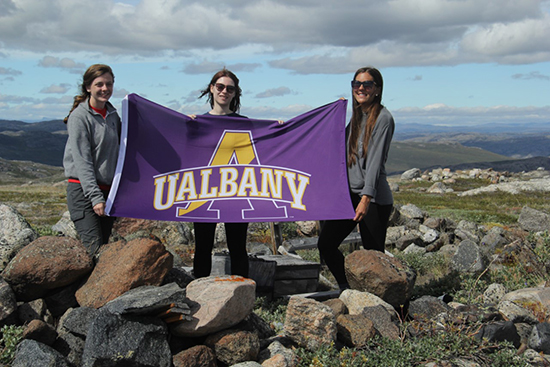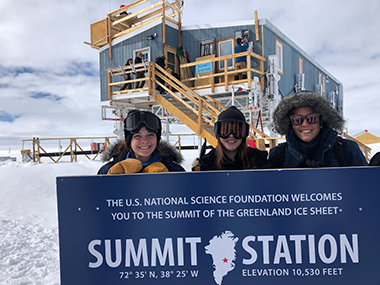UAlbany Students Explore the Greenland Ice Sheet on Research Expedition
 |
|
From left: Celia Werner '21, Chelsea Elizabeth Snide '19, Allison Finch '20. |
ALBANY, N.Y. (July 9, 2019) – Three UAlbany undergraduate students spent their first days of summer far away from sandy beaches and scorching temperatures – instead conducting experiments around the second-largest ice sheet on the planet.
The students were part of a large team of researchers, also including undergraduates from the University of Michigan and Virginia Tech, who recently returned from an 11-day expedition to the Greenland Ice Sheet.
Led by Perry Samson ’72, ‘74, a University of Michigan professor and Department of Atmospheric and Environmental Sciences (DAES) double alum, and supported by the National Science Foundation (NSF), the trip offered undergraduate students an opportunity to explore authentic atmospheric and space science issues on the massive, Arctic island.
It also commemorated a University of Michigan Greenland expedition in 1926, led by professor William Herbert Hobbs. His team’s journey led to some of the island’s first meteorological and geological observations.
“The power of experiential learning opportunities such as this is less what is learned during the expedition and more about the creation of new questions which will drive curiosity afterward,” said Samson. “When I was a student at UAlbany it was an opportunity like this that galvanized my interest in atmospheric studies. It’s my sincere hope that the students who participated in this expedition will be challenged to deepen their exploration of the science of climate.”
Students first joined at UAlbany for several days of preparation, including a training session in the College of Emergency Preparedness, Homeland Security and Cybersecurity (CEHC) drone lab, where they learned how to visually map conditions of the ice sheet. They then climbed aboard a United States Air Force Guard LC-130 at Stratton Air National Guard Base in Schenectady on June 18, traveling more than 1,800 miles north.
 |
|
The Summit Camp, also know as the Summit Station, is a year-round research station on the apex of the Greenland Ice Sheet. Its coordinates are variable, since the ice is constantly moving.
|
Their expedition was based in Kangerlussuaq, a community on the island’s southwestern coast. Starting from base camp, the students ventured out over the tundra to conduct experiments around the Greenland Ice Sheet, and also flew to its nearby Summit Station, a year-round remote research station managed by the NSF.
Greenland’s "melt season" typically runs from June to August, with the bulk of melting occurring in July. But this year, the island is experiencing unusual ice melt, losing an estimated 2 billion tons in just a single day last month. A previous study published in 2016 by UAlbany atmospheric scientist Jiping Liu found a link between Arctic sea ice loss and Greenland’s shrinking ice sheet, which in turn is contributing to rising global sea levels.
The students' experiment results will help record a snapshot of the current state of Greenland’s climate conditions.
“Our expedition to Greenland centered on recreating atmospheric measurements made by Prof. Hobbs in 1926,” said Chelsea Elizabeth Snide, a 2019 DAES graduate. “Seeing the ice sheet up close was breathtaking. I could not believe how large it was, and how surprisingly sandy it gets. Most unexpected though was the amount of glacial melt that we saw both first hand and through our plane window.”
“Being able to go to Greenland was truly a once in a lifetime experience,” added Allison Finch, an incoming DAES senior. “The knowledge I’ve come back with, whether it be about the katabatic winds, climate change, or sled dogs, is something I would have never been able to learn and understand in a classroom setting. It has shown me how important field work and first hand experiences are for students.”
“This trip to Greenland was a unique opportunity to experience taking atmospheric and climate measurements out in the field,” said Celia Werner, an incoming DAES junior. “Seeing the glaciers and ice sheets of Greenland, that have such a huge affect on our global climate, was life changing and affirmed me in my studies of atmospheric science.”
The research team returned to the U.S. on June 28.
You can learn more about their trip in this Times Union article. More information on Hobbs’ 1926 expedition can be found in his book titled The North Pole of the Winds, archived by the University of Michigan.
![]() For more news, subscribe to UAlbany's RSS headline feeds
For more news, subscribe to UAlbany's RSS headline feeds
A comprehensive public research university, the University at Albany-SUNY offers more than 120 undergraduate majors and minors and 125 master's, doctoral and graduate certificate programs. UAlbany is a leader among all New York State colleges and universities in such diverse fields as atmospheric and environmental sciences, business, education, public health,health sciences, criminal justice, emergency preparedness, engineering and applied sciences, informatics, public administration, social welfare and sociology, taught by an extensive roster of faculty experts. It also offers expanded academic and research opportunities for students through an affiliation with Albany Law School. With a curriculum enhanced by 600 study-abroad opportunities, UAlbany launches great careers.


